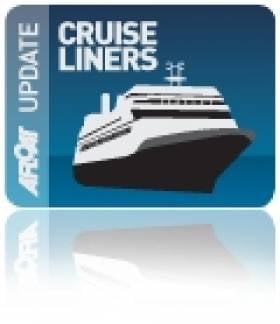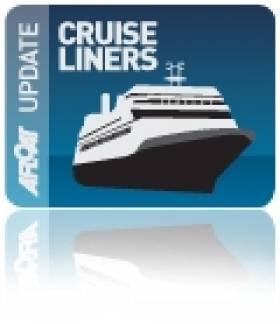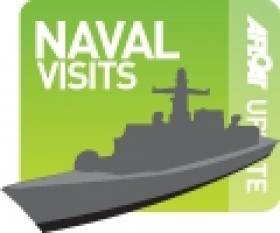Displaying items by tag: Port of Cork News
Queen’s Namesake to Retrace Royal Visit
The 90,901 gross registered tonnes cruise ship is to depart her Hampshire homeport, where she is to similarly follow the monarch in that she is scheduled to make a port of call to Dublin first on 9 September and make a call to Cork afterwards.
With a length of 295m / 965-feet the vessel will dock in the centre of the capital port before she sails overnight to make a morning arrival at Cobh, the dedicated cruise terminal for the Port of Cork. She is scheduled to stay at the Cork Harbour town formerly named Queenstown until a 17.00 hour departure.
Her visit coincides with Cork Harbour Open Day, where visitors can view the impressive vessel from the quayside, for more details visit www.corkharbour.ie
Incidentally her near-sister Queen Victoria also called to Dublin in May and the remaining vessel of the Cunard fleet, the 'flagship' liner Queen Mary 2 is also to dock in Cobh three days later after Queen Elisabeth's visit.
- Cobh
- Cork Harbour
- port of Cork
- Cruise Liners
- Cork Harbour Open Day
- Ports and Shipping
- Cobh Cruise Terminal
- Queen Elizabeth II
- Cork Harbour News
- Port of Cork Company
- Cunard Line
- queen victoria
- Port of Cork News
- Queen Elizabeth
- Queen Mary 2
- QM2
- Cruise Liner news
- TransAtlantic Liners
- Cruise ships
- Irish cruiseship calls
- Queen's visit to Ireland
- QV
- QE
- Cunarders
- Cobh Cunarders
- Cobh cruise calls
- Cunard liners
- Cunard cruiseships
- Royal visit to Ireland
- Cobh cruise liners list
Loop Head: A Guiding Light for Foynes-Bound Cruise Calls
Her arrival will be followed by P&O Cruises latest addition Adonia on Saturday. With 710 berths the 30,000 tonnes vessel is the smallest of the seven-strong fleet which can accommodate between 1,800 and up to 3,100 passengers as in the case of the Azura. The 115,000 tonnes vessel departed Dublin Port this evening. Her first call to the port was last year (click HERE) and she is the largest cruise ship to call to the capital.
On Tuesday of next week the 9,000 tonnes Spirit of Adventure (cruises) marks the third cruise caller to Foynes. The port is along with five other terminals located throughout the country's largest estuary are operated by the Shannon Foynes Port Company (SFPC).
Incidentally Spirit of Adventure and Azura where two of another trio of cruise ships that visited the Port of Cork on Monday, with Holland America Line's 59,000 tonnes Rotterdam forming the third vessel. This was the first occasion that Cork has handled this number of cruise ships on a single day, bringing 7,000 passengers which set a new record for the port.
- Shannon Estuary
- Shannon Foynes Port Company
- P&O Cruises
- Loop Head
- Cruiseships
- lighthouses
- Dublin Port news
- Holland America Line
- Port of Cork News
- Le Diamant
- Cruiseliners
- Spirit of Adventure
- Shannon Estuary news
- Loop Head Lighthouse visitor centre
- Azura cruise ship
- Spirit of Adventure cruiseship
- Adonia cruiseship
- Rotterdam cruiseship
- Loop Head Lighthouse
- Shannon Estuary and River
- Shannon Estuary and River news
- Lighthouse news
- Irish cruise calls
- Irish ports of call
- Foynes Port
Not One Not Two but Three Cruise Callers to Cork
Next in terms of tonnage is Holland America Line's near 60,000 tonnes Rotterdam, for more about the 1997 built click this LINK. The final member of the trio belongs to Saga Cruises subsidiary Spirit of Adventure cruises, the 10,000 tonnes Spirit of Adventure. For a visual virtual tour of the vessels interior facilities click HERE.
Spirit of Adventure was scheduled in late April on a 14-day 'Relics of Rome' cruise which was to include ports of call to Libya, Tunisia and Egypt but this was cancelled due to the political situation throughout North Africa.
The combined cruise calls to Cork Harbour has a potential capacity of 5,200 passengers and the mid-July arrival confirms the ports popularity which is to welcome this year a total of 54 cruiseships and over 100,000 passengers. Azura and Spirit of Adventure are to share the berth at Ringaskiddy while the Rotterdam is to berth at the dedicated cruise terminal in Cobh.
The Empire Strikes Back
The 14,620 dwt US-based training-ship Empire State made a return call to the Port of Cork last night for a four-day stay, writes Jehan Ashmore.
At over 172m long the cruiser-sterned vessel with a port of registry of New York, moored at the Cobh Cruise Terminal which was recently visited by another US training ship, State of Maine (click HERE).
The veteran vessel now in her sixth decade of service and is the also the sixth training-ship to carry the name 'Empire State' for the State University of New York (SUNY) Maritime College.
Empire State was laid down as SS Oregon at the Newport News Shipbuilding and Drydock Company, Newport News, Virginia. She was launched in 1961 for the States Steamship Company and delivered a year later for service in the Pacific trades. For further information about the vessel's interim career before she was converted for her current role click HERE.
Despite her conversion she still presents a distinctive profile with the superstructure positioned amidships between the cargo-holds.
Prior to the Empire State's arrival the French cruiseship Le Diamant departed Cobh for an overnight passage to Dublin, where last year the Empire State made a port of call.
The next cruise-caller to Cobh is the 296-passenger Silver Cloud which is scheduled to dock on Monday evening.
- Dublin Port
- Cobh
- Cork Harbour
- port of Cork
- New York
- Silver Cloud
- Cobh Cruise Terminal
- Cruiseships
- Cork Harbour News
- State of Maine
- Port of Cork News
- Training Ship
- Empire State
- Suny Maritime College
- La Diamant
- Newport News and Shipbuilding
- Newport News
- States Steamship Company
- State University of New York
Ferry Operator Assists in Marine-Life Conservation Role
Fastnet Line which runs the Cork-Swansea port route on the Celtic Sea, is assisting the charity MarineLife to monitor cetaceans, writes Jehan Ashmore.
The work of MarineLife is to survey the population trends and track the movements of dolphins, whales, porpoises and other wildlife. The research is undertaken onboard Fastnet Line's Julia (1981/21,699grt) and access to the ferry is provided free-of-charge to the wildlife-based charity.
During the months of July and August the ferry's schedule will allow for further opportunities to conduct daylight sightings of marine-life which is to be posted on MarineLife and Fastnet Line websites.
Adrian Shephard, Chairman of MarineLife Trustees, said: "The route from Swansea to Cork crosses a range of marine habitats and we hope it will generate many sightings of cetaceans and seabirds, including two important species we monitor, the white-beaked dolphin and the balearic shearwater".
In addition monitors recently observed fin whales, the second largest whale on the planet. Such sightings provide vital information and this will contribute to a better understanding of the distribution of cetaceans and other marine life in the Celtic Sea. To read more www.marine-life.org.uk
The first of four summertime surveys is to take place on 10 July. Overall the research by MarineLife is part of a larger project which also involves the use of other ferries operating in the Irish Sea and those serving on UK continental routes.
The 1,500 passenger / 325 car-carrying Julia sails year-round six times a week between September to June and from next month and during August the vessel will provide eight sailings per week. For fares and sailings schedules contact www.fastnetline.com
A Weekend to Explore the 'Bounty'
The Cork-berthed replica HMS Bounty, the purpose built movie prop tallship used in the 1962 MGM studies film release of 'Mutiny and the Bounty' starring Marlon Brando, will be open to visitors from tomorrow, writes Jehan Ashmore.
The famous tall ship is to open to the public between (11am-6pm) and these times also apply to the Saturday and Sunday. Tours on board the Bounty are self-guided with crew assistance. Admission charges are €10 for adults and children €5, children under four years go free.
The Bounty is berthed at Albert Quay which faces opposite the Cork City Marina on the south quays of the city-centre.
The public can explore her "tween" deck 8' foot ceilings, this made it easier for the film crew and their equipment to access.
As a result, Bounty has been hired by filmcrews for the making of 'Treasure Island', 'Yellowbeard', 'Sponge Bob, Square Pants, the Movie' and 'Pirates of the Caribbean - Dead Man's Chest'. In addition to commercial movies, Bounty has also been the stage for many documentaries.
To compare the differences between the replica and the original 18th century built 'Bounty' click HERE.
Lee Looks Ahead to All Antarès Arrival
A trio of French Naval mine-route survey craft are to sail upriver of the River Lee this Friday and are to berth in the Port of Cork at the North Custom House Quay, writes Jehan Ashmore.
The craft BRS Antarès (M 770), BRS Altaïr (M 771) and BRS Aldébaran (M 772) represent all of the three-ship Antarès-class which are based in the Breton naval base of Brest. At 28m long the rather stout-looking craft (photo) weigh some 250 tonnes displacement and have a crew of 23.
Leadship of the class BRS Antarès entered service in 1993 and was followed by the remaining pair which too were built by Chantier (Socarenam) in Boulogne-sur-Mer.
In March the BRS Altaïr accompanied the minehunter CMT Cassiopée (M642) to Dublin for a four-day visit during the St. Patrick's Day festival.
A floating crane-barge with a 1,000 ton lifting capacity hoisted the structure sky-high away from the ship which was berthed at the Grand Bahama Shipyard drydock facility. The ships owners, Princess Cruises cited the main reason for the removal was in order to 'significantly improve the operational performance of the ship, including greater fuel efficiency.'
Grand Princess may have lost her signature Skywalker Nightckub but three-decks below a new nightclub, One5, inspired by its Deck 15 location was created. In addition to this work which took place during April and May the 2,600 passenger cruisehip also underwent a major refit. The ship which had its last major refurbishment in 2004 has amenities to include an outdoor movie screen, fitness centre, spa, casino and four swimming pools.
For 'interactive' deckplans click here and interior slideshow click this link.
The distinctive 'Skywalker' feature became one of the most iconic in cruiseship naval architecture when the Grand Princess was launched as leadship
of the 'Grand' class in 1998. Located at the extreme aft of the vessel, the nightclub could only be reached by clubbers using an angled walkway (photo). Externally the feature was referred by some as the 'shopping trolley' and others percieved the design infleunce from towering poops found on ancient war-faring galleons.
Irrespective of the design origins, another 10 'Grand' class vessels were built by the Italian Fincantieni (at Malfalcone) Shipbuilding Group. The 'handle' (photo) feature on the Grand Princess was made with a heavier material compared to Golden Princess (2001) and Star Princess completed a year later. So there are no plans to remove these nightclubs. Of the more recent additions to the class modifications have appeared, notably without the inclusion of the Skywalker Nightclub's but there are changes to funnel designs.
Outside the Princess Cruises brand, the Ventura and Azura (also of the Grand-class) operate for P&O Cruises, serving the UK market from Southampton. The Hamsphire port welcomed the pioneering leadship Grand Princess on 5 May after she made a 16-day trans-Atlantic repositioning voyage from Port Everglades.
The cruiseship which has a crew of 1,200 alone will make the UK port its seasonal homeport this year from where she sails on cruises in Europe. On one of these cruises itineraries the Grand Princess (290m long x 36 beam X 8.5m draft) included a visit to the Port of Cork today. You can monitor the ship from Cobh Cruise Terminal via the 'live' bridge web-cam, noting the vessel is due to depart at 18.00 this evening bound for Dublin Port.
Grand Princess became the first cruiseship to measure over 100,000 gross registered tonnes when the 108,806 (grt) vessel docked in Dublin on 31 August 2004.
Last year the port handled 88 cruisecalls and this number of vessels is to be closely repeated this season. Over 200 cruise calls with around half a million passengers and crew are scheduled to visit the island of Ireland. The cruise sector business is estimated to generate €60m to the economies
north and south.
Finnish Minelayer to Visit Cork
The Finnish Navy minelayer FNS Hämeenmaa is to dock in the Port of Cork at the city's central North Custom House Quay tomorrow morning, writes Jehan Ashmore.
FNS Hämeenmaa entered service in 1992 and measures 1,450 tonnes, she is the namesake class of two minelayers, the second FNS Uusimaa was also built by Finnyards in the same year.
At nearly 78m long the steel hulled vessels which have an alloy superstructure are designed to operate throughout the year in the demanding Baltic Sea conditions and the in the archipelago's.
They have an ice operating classification of ICE-1A and for military purposes they became one of first Finnish Navy vessels to incorporate stealth technology features. The pair are primarily tasked for minelaying duties but they also provide roles acting as an escort, transport and depot ships.
Armament comprises of 1 × Bofors 57 mm dual-purpose gun, 1 × eight-cell ItO 04 surface-to-air missile launcher, 2 × anti-submarine rocket launchers, 2 × depth charge rails and 100-150 sea mines (four mine laying rails).
Based in Pansio, the 20 knot vessels each have a crew complement of 60 personal. In total the Finnish Navy has around 2,100 officers, officer specialists and warrant officers, military personnel and civilian's workers.
On an annual basis close to 3,900 conscripts, of which approximately 30 are women volunteers do their military service in the navy. In addition about 3,400 reservists are trained yearly in naval refresher courses.
Cobh Cruiseships Come and Go (Footage)
On Friday the Port of Cork welcomes another large cruiseship in the form of the Emerald Princess which carries 3,592 passengers, nearly 500 more than the Celebrity Eclipse. The 113,000 tonnes vessel is nearly 950-feet long, is 118 wide and draws 28 feet under the waterline. With 19 decks the vessel towers above the oceans and will also do so when alongside Cobh's 350m deepwater berth.
One of the numerous amenities onboard is the CyberGolf link and jogging track which are located high up near the stern. Directly situated below is the Skywalkers Nightclub and for movie-goers, films are shown at an oudoor theatre. The top of the range cabins are the 900 balcony staterooms which offer first class hotel style 24-hour room service.






































































